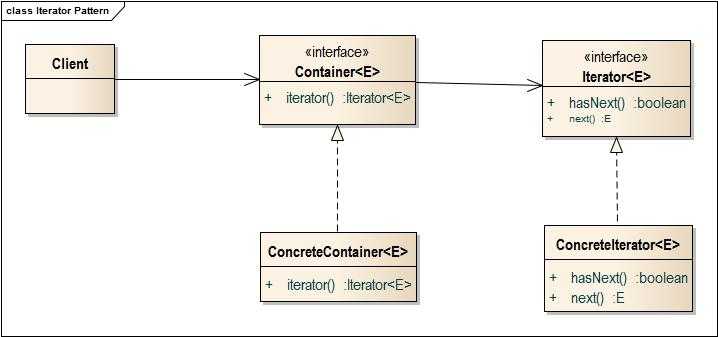标签:
迭代器模式:提供一种方法访问一个容器对象中各个元素,而又不需暴露该对象的内部细节。
抽象迭代器:抽象迭代器负责定义访问和遍历元素的接口。迭代器的抽象是为了使迭代器不依赖于容器的内部结构。
具体迭代器:具体迭代器要实现迭代器接口,并要记录遍历中的当前位置。
抽象容器:抽象容器负责提供创建迭代器的接口。
具体容器:具体容器要实现创建具体迭代器的接口,这个具体迭代器与该具体容器的内部结构相关。

抽象迭代器:
package com.huey.pattern.iterator; /** * the iterator interface * @author huey * @version 1.0 * @created 2015-11-26 * @param <E> */ public interface Iterator<E> { public boolean hasNext(); public E next(); }
具体迭代器:
package com.huey.pattern.iterator; import java.util.Arrays; /** * the concrete iterator * @author huey * @version 1.0 * @created 2015-11-26 * @param <E> */ public class SortedIterator<E> implements Iterator<E> { private E[] items; int index = 0; public SortedIterator(E[] items) { this.items = items; if (items != null && items.length > 0 && items[0] != null && items[0] instanceof Comparable<?>) { Arrays.sort(this.items); } } @Override public boolean hasNext() { if (items == null || index >= items.length || items[index] == null) { return false; } return true; } @Override public E next() { E item = items[index++]; return (E) item; } }
抽象容器:
package com.huey.pattern.iterator; /** * the container interface * @author huey * @version 1.0 * @created 2015-11-26 * @param <E> */ public interface Collection<E> { public boolean add(E e); /** * get the iterator * @return */ public Iterator<E> iterator(); }
具体容器:
package com.huey.pattern.iterator; import java.lang.reflect.Array; import java.util.Arrays; /** * the concrete container * @author huey * @version 1.0 * @created 2015-11-26 * @param <E> */ public class SortedList<E> implements Collection<E> { private E[] items; private int size; @SuppressWarnings("unchecked") public SortedList(Class<E> type) { items = (E[]) Array.newInstance(type, 10); size = 0; } public boolean add(E e) { ensureCapacity(size + 1); items[size++] = e; return true; } @Override public Iterator<E> iterator() { return new SortedIterator<E>(items); } public void ensureCapacity(int minCapacity) { int oldCapacity = items.length; if (minCapacity > oldCapacity) { int newCapacity = (oldCapacity * 3) / 2 + 1; if (newCapacity < minCapacity) newCapacity = minCapacity; // minCapacity is usually close to size, so this is a win: items = Arrays.copyOf(items, newCapacity); } } }
单元测试:
package com.huey.pattern.iterator; public class IteratorPatternTest { public static void main(String[] args) { Collection<Long> container = new SortedList<Long>(Long.class); container.add(2L); container.add(0L); container.add(1L); container.add(5L); Iterator<Long> iterator = container.iterator(); while (iterator.hasNext()) { Long item = iterator.next(); System.out.println(item); } } }
结果输出:
0 1 2 5
1) 访问一个集合对象的内容,而无须暴露它的内部表示。
2) 支持对集合对象的多种遍历方式。
3) 为遍历不同的集合对象结构提供一个统一的接口。
迭代器对于集合容器类的遍历非常有效和实用,在 JDK 中,已经定义了 java.util.Iterator、java.lang.Iterable、java.util.Collection 等接口。
标签:
原文地址:http://www.cnblogs.com/huey/p/4997338.html